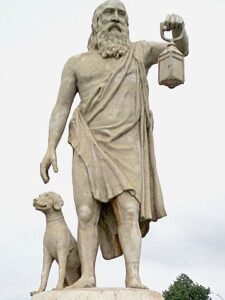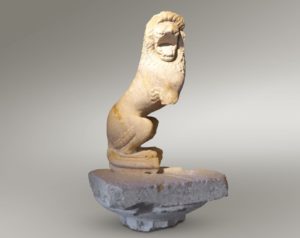[4] ἀνιοῦσι δὲ ἐς Κόρινθον καὶ ἄλλα ἐστὶ κατὰ τὴν ὁδὸν μνήματα καὶ πρὸς τῇ πύλῃ Διογένης τέθαπται ὁ Σινωπεύς, ὃν κύνα ἐπίκλησιν καλοῦσιν Ἕλληνες. πρὸ δὲ τῆς πόλεως κυπαρίσσων ἐστὶν ἄλσος ὀνομαζόμενον Κράνειον. ἐνταῦθα Βελλεροφόντου τέ ἐστι τέμενος καὶ Ἀφροδίτης ναὸς Μελαινίδος καὶ τάφος Λαΐδος, ᾧ δὴ λέαινα ἐπίθημά ἐστι κριὸν ἔχουσα ἐν τοῖς προτέροις ποσίν.
- Map
- Pre Reading
- Post Reading
- Culture Essay
Two memorable tombs lay near one of Corinth’s city gates, Diogenes the Cynic philosopher and the courtesan Lais.
Diogenes hailed from Sinope, a town on the southern shore of the Black Sea. Exiled from his hometown after 362, he lived the rest of his life in Athens and finally Corinth until his death in 323 BCE. His outrageous lifestyle (going barefoot, sleeping in tubs or at crossroads, pissing in public) was designed to expose the corruption and contradictions of living according to convention. Given the epithet Cynic (from κύων κυνός dog) because of his shameless rejection of custom, he reveled in this name, saying “other dogs bite their enemies, I bite my friends to save them” (Stobaeus, Florilegium, 3.13.44).
Most Greeks would consider the lives of Diogenes and Lais shameful and scandalous. Why would the Corinthians permit–indeed, show honor to–the tombs of Diogenes and Lais by siting them near the entrance to their city? What about the lives of these two figures was appealing to the Corinthian ethos?

